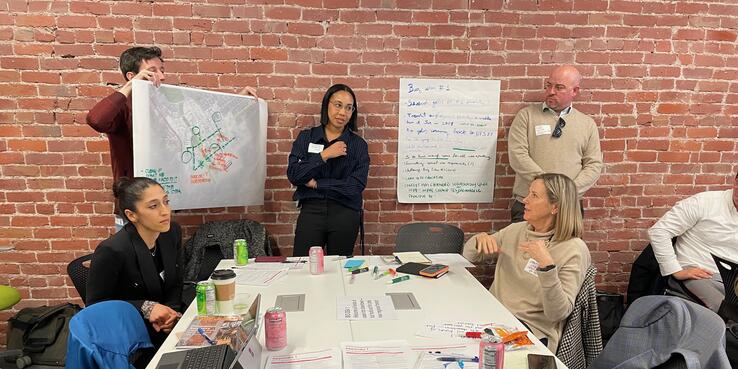Downtown San José is the densest, most walkable, most transit-rich, and most culturally dynamic urban center in the South Bay. Major public transit investments and large new development projects are on the horizon, but they will take time to complete. In the meantime, downtown needs more people, amenities, and vitality to realize its full potential as a 24-hour district and a destination within the region.
SPUR’s 2014 report The Future of Downtown San José outlined six big ideas for the urban center to become even stronger:
- Welcome all kinds of uses into downtown — but hold out for jobs near regional transit.
- Make sure that what gets built adheres to key urban design principles.
- Promote a larger area of “Central San José” with downtown as its core.
- Make it easier to get to and through downtown without a car.
- Retrofit downtown to be more pedestrian-oriented.
- Build on downtown’s strengths as the cultural and creative center of the South Bay.
Ten years later, downtown San José has attracted new development and infrastructure investments, and economic and social conditions have shifted due to COVID, with considerably fewer people working in downtown office buildings. Nevertheless, downtown’s importance to the region and its potential to become a successful transit-oriented employment center and mixed-use hub is unchanged.
This spring, SPUR convened the City of San José, major employers, community groups, designers, and other civic leaders to attend a half-day workshop to develop an implementation agenda for the revitalization of downtown San José grounded in our previous research. The meeting objectives were to learn about current conditions downtown and ongoing efforts led by the city and other stakeholders, to review and refresh the strategies from SPUR’s Future of Downtown report; to discuss the potential implementation priorities that SPUR could lead to enhance planning, transportation, housing, and public spaces; and to spend time together as a community.
Dena Belzer of Strategic Economics kicked off the workshop with a comprehensive overview of downtown San José’s current economic and market conditions, setting the stage for informed discussions. Panelists from the City of San José, the San José Downtown Association, and Movimiento de Arte y Cultura Latino Americana (MACLA) described initiatives to increase foot traffic in the downtown district.
In small-group exercises, participants revisited the six big ideas outlined in SPUR’s 2014 report, reflecting on changes and envisioning innovative approaches to promote downtown. In these discussions, participants confronted the evolving context of downtown San José, acknowledging shifts in work patterns, housing dynamics, public safety concerns, and homelessness. These challenges underscored the need for proactive strategies aimed at fostering a more inclusive, prosperous, and resilient urban core.
The participants affirmed that the six big ideas from our 2014 report were still relevant and that SPUR plays a valuable role as a thought leader, convener, and advocate with expertise in research and policy. However, participants also agreed that new approaches that focused on implementation actions are needed. They proposed strategies focused on enhancing the pedestrian experience, securing funding for transformative projects, and celebrating San José’s arts and culture heritage. The vision is clear: a people-oriented district that thrives as a hub of creativity, commerce, and community.
Drawing inspiration from successful urban revitalization efforts worldwide, participants identified key nodes and institutions within downtown, laying the groundwork for future initiatives. The workshop sparked many questions for future policy research:
- How can partnerships between the city and its arts, culture, and educational institutions be strengthened and maximized to enhance their impact on downtown?
- What can we learn from other cities that have successfully created an arts, culture, and education strategy for neighborhood revitalization?
- How can we activate vacant spaces on the ground floor to create a more welcoming and prosperous mixed-use district? What types of tenants could likely work in these spaces?
- What would motivate property owners to lease spaces to unconventional tenants (artists, small businesses, cultural organizations)? What creative financing strategies could make this strategy work at scale?
Getting from these big questions to implementable policy solutions will not be fast or easy. It will take robust policy analysis and the collaboration of local government, property owners, businesses, community groups, and civic organizations. SPUR remains dedicated to the vision of downtown San José as a more prosperous and inclusive environment, fostering a sense of belonging for residents, employees, and visitors alike.
SPUR thanks Kristy Wang and Community Planning Collaborative for organizing and facilitating the workshop discussions.
